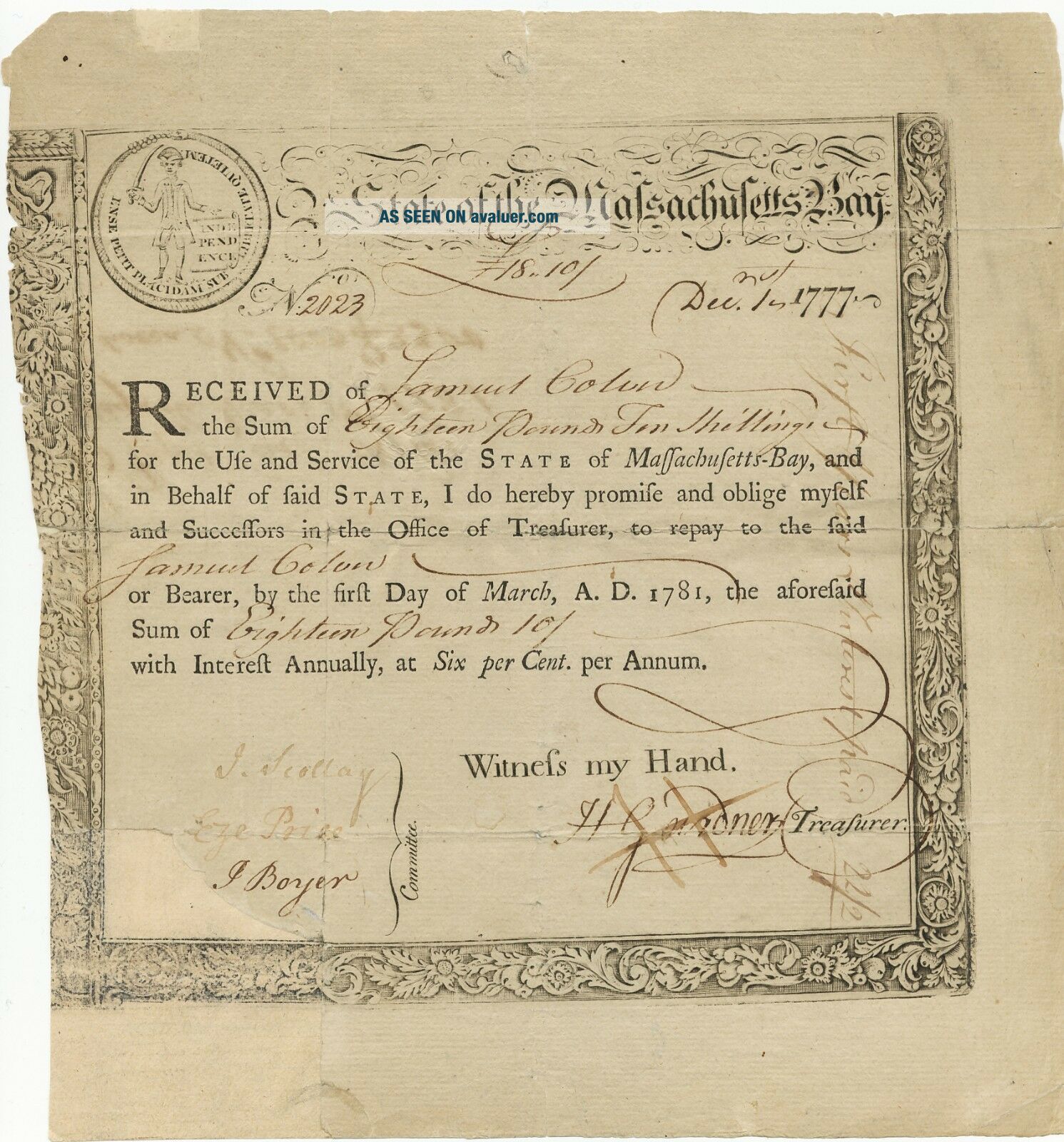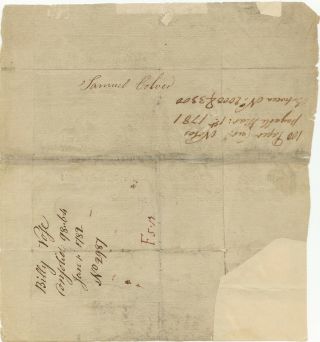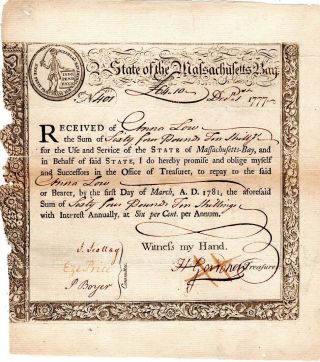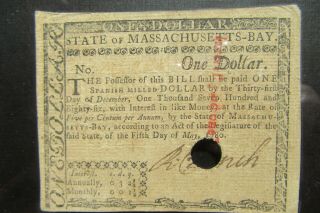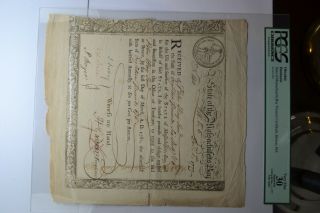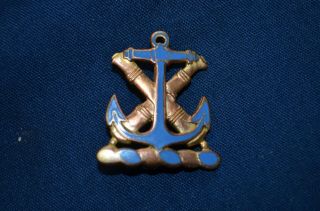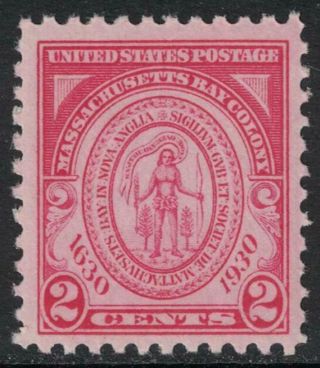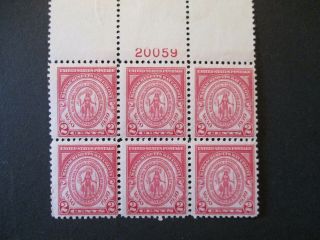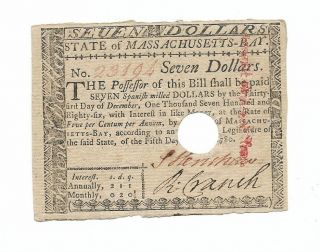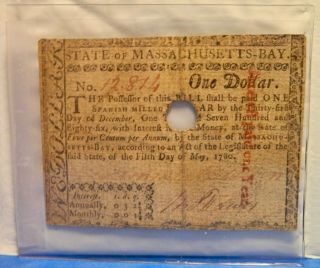RARE State Of Massachusetts Bay State Treasury Certificate Dec. 1, 1777 18 Pounds
Item History & Price
| Reference Number: Avaluer:42531336 | Country of Manufacture: United States |
| Circulated/Uncirculated: Circulated | Type: Colonial |
| Denomination: 18 pounds |
Quality backed by a professional dedicated staffPlease make sure you go to our 'other items' to check out our other valuable items.We will be posting many more items from this estate find!YOUR OPPORTUNITY TO OWN A PIECE OF AMERICAN HISTORY AN INVESTMENT THAT'S GUARANTEED TO APPRECIATE IN VALUEVERY FEW OF THESE EXIST
RARE State of Massachusetts Bay State Treasury Certificate Dated December 1, 1777 Eighteen Pounds December 1st, 1777 - Dated Revolutio...nary War Period. State of Massachusetts Bay.which features the sword in hand vignette -- based on designs by Paul Revere and was engraved by Nathanial Hurd (read Biography below)Embossed blind stamp. Issued for 18 Pounds, on or before March 1st, 1781Printed on period watermarked laid paper, 8.5” x 9” Ornate decorative border frame, left end indent and wide, full margined. EF condition.Signedby Henry Gardner Treasurer (read Biography below)Only 76 - 200 of these survive. (read below)
Massachusetts Treasury Certificates - dated Dec.1, 1777 (due March 1, 1781)During the Revolutionary War the Commonwealth of Massachusetts issued several bills of credit in lieu of payment for goods and services they needed. Individuals who were issued these bills of credit could use them to pay taxes or could hold on to them in hopes of payment at a future date. At times these notes were also sold at a discount to speculators or may have been used as currency, if the other party was willing to accept them. By 1777 so many different types of bills of credit had been issued by the Commonwealth that the situation was confusing and payment was in some cases long overdue. On October 13, 1777 an act was passed to consolidate all outstanding bills of credit. By this act all bills of credit (excepting small change notes under one dollar) were to be exchanged for treasury notes. Bills of credit did not accrue interest for they were considered short term loans for which the holders soon expected compensation from the Commonwealth. By this act these bills were converted into longer term treasure notes but with the benefit of accruing six per cent interest. In this exchange the first £250, 000 in bills of credit received by the treasurer would be exchanged for certificates bearing 6 per cent interest with a due date of March 1, 1781. Any additional outstanding bills of credit would be exchanged for similar certificates but with a due date of March 1, 1782. Certificates were issued in denominations of £10 and above. Individuals were given until January 1 , 1778 to make the exchange. After that date any outstanding bills of credit were deemed to be void and anyone attempting to pass one was subject to a £5 fine. Soldiers and others who were prevented from participating in the exchange in a timely manner were given an additional year to make the exchange, provided they produced a certificate stating they swore an oath before a justice of the peace that they had been prevented from participating in the exchange. The law also provided for £400, 000 in individual and property taxes to be collected in 1780 which would provide the funds to pay off the certificates. Unlike most treasury receipts which begin "Borrowed and received of" this issue simply states "Received of" as the funds had been borrowed at an earlier date. The certificates were printed from a copperplate engraved by Nathaniel Hurd with the vignette of a soldier with a sword in his right hand and a scroll with "Independence" in his left. Around this is the state legend "Ense petit placidum sub libertate quietem." (By the sword one seeks peace under tranquil liberty). The entire symbol is encircled by a rattlesnake. According to Brigham the floriate acanthus border was copied from an earlier border Hurd had engraved in 1769. The title "State of Massachusetts-Bay, " "No." the date "1777" followed by a geometric design, the word "Committee." as well as the bracket and the phrase "Witness my Hand, " are all engraved. The remainder of the certificate is typeset or handwritten. According to the act a committee of John Scollay, Peter Boyer and Ezekiel Price would sign the blank forms before the treasurer completed them. Anderson has estimated at least 6, 200 of these certificates were issued with between 76-200 surviving.Nathaniel Hurd (ca.1729-1777) was an engraver and silversmith in Boston, Massachusetts. Hurd was a Patriot in the American Revolution and opposed to inherited wealth and privilege. In the 18th century.He engraved "bookplates ... heraldic devices, seals, ... paper currency, and business cards. Examples of Hurd's work are in the collections of Harvard University; Historic Deerfield, and the Museum of Fine Arts Boston. He became particularly proficient as an engraver and styled himself "Goldsmith & Engraver" in his will. Revere's account book of 1762 debited Hurd for "2 small scolop'd Salvers, " a chafing dish, a pair of canns, a silver frame for a picture, and, uniquely, a "Silver Indian Pipe." The following year, "mending a Picture frame" and making a snuff box complete the transactions, for which payment was prompt. Hurd cut a variety of plates for Harvard College, and a table of coins which must have been helpful to his contemporaries. He cut for James Breck, who dedicated the view to the Hon. Thomas Hubbard, a "South Prospect of the Court House, Boston" published for the first time in R.I. 1965. He died unmarried in 1777HenryJoseph Gardner (June 14, 1818 – July 21, 1892) wasthe 23rd Governorof Massachusetts from1855–1858. Gardner was the candidate of the Know-Nothingmovement, andwas elected governor as part of the sweeping victory of Know-Nothingcandidates in the Massachusetts electionsof 1854.Early lifeHenryGardner was born in Dorchester, Massachusetts (thena community separate from Boston)on June 14, 1819, to Henry Gardnerand Clarissa Holbrook Gardner. He was educated in private schools inthe Boston area, and then attended Phillips ExeterAcademy.After graduating in 1831, he studied at BowdoinCollege, where he graduated in 1838. He then embarked on a careeras a drygoods merchant, acting as a principal partner for many years. In 1844 he marriedHelen Cobb of Portland, Maine.PoliticalcareerIn1850 Gardner, politically a Whig, was elected to the BostonCity Council, serving until 1853. He then became involved with the KnowNothing movement, winning election as governor of Massachusetts by a wide margin. Inline with the nativist and anti-Catholic politicsof the movement, Gardner proposed an amendment to the Massachusettsstate constitution banning appropriationsof tax funds to Catholic schools, which was passed by the statelegislature and ratified after it was approved by referendum.BeforeGardner's election, on May 24, 1854 AnthonyBurns wasarrested in Boston underthe FugitiveSlave Law of 1850. EdwardG. Loring, a SuffolkCounty probatejudge who also as served U.S. commissioner of the Circuit Court in Massachusetts, ordered that Burns be forced back into slavery in Virginia, outraging abolitionistsandthe increasingly antislaverypublic in Massachusetts. Under the pressure of a public petitioncampaign spearheaded by WilliamLloyd Garrison, thelegislature passed two Bills of Address calling for Judge Loring tobe removed from his state office, in 1855 and 1856, but in bothcases Gardner declined to remove Loring. (A third Bill of Address toremove Loring from office was later approved by Gardner's Republican successor, NathanielPrentice Banks.)The Know-Nothing legislature also passed, over Gardner's veto, oneof the most stringent personalliberty laws, designed to make enforcement of the FugitiveSlave Act of 1850 asdifficult for slaveclaimants as possible. Gardner claimed that the law would exacerbaterelations between North and South, and called for itsrepeal. Minority parties in the legislature sought to weaken thebill, but its major provisions, including rights of habeas corpus, jury trial, and state-funded defense, survived.Later lifeGardnercontinued in his dry goods business until 1876, and became aninsurance agent in 1887. He died in Milton, and wasmade a member of the Ancientand Honorable Artillery Company in1855.
For your protection, we make all our coin, currency, and rarities transactions private, so that you will remain anonymous to other Ebay users. We keep all our financial information private and secure. We do not wish our client's information to be available to anyone.Shipping on these items will include insurance and packaging as fragile items.We value your items as much as you will... Our shipping rates are for Fed EX and USPS. It includes professional packaging, insurance, and delivery confirmation. It may also include bonded shipping, certified mail, signature confirmation, and return receipt, depending on the item shipped. We get your items to you undamaged, and as quickly as possible.
SQUARE TRADE VERIFIED SELLER guarantees a commitment to excellence. HSC thanks you for taking the time to view our auctions on EBAY
03770
RARE State of Massachusetts Bay State Treasury Certificate Dated December 1, 1777 Eighteen Pounds December 1st, 1777 - Dated Revolutio...nary War Period. State of Massachusetts Bay.which features the sword in hand vignette -- based on designs by Paul Revere and was engraved by Nathanial Hurd (read Biography below)Embossed blind stamp. Issued for 18 Pounds, on or before March 1st, 1781Printed on period watermarked laid paper, 8.5” x 9” Ornate decorative border frame, left end indent and wide, full margined. EF condition.Signedby Henry Gardner Treasurer (read Biography below)Only 76 - 200 of these survive. (read below)
Massachusetts Treasury Certificates - dated Dec.1, 1777 (due March 1, 1781)During the Revolutionary War the Commonwealth of Massachusetts issued several bills of credit in lieu of payment for goods and services they needed. Individuals who were issued these bills of credit could use them to pay taxes or could hold on to them in hopes of payment at a future date. At times these notes were also sold at a discount to speculators or may have been used as currency, if the other party was willing to accept them. By 1777 so many different types of bills of credit had been issued by the Commonwealth that the situation was confusing and payment was in some cases long overdue. On October 13, 1777 an act was passed to consolidate all outstanding bills of credit. By this act all bills of credit (excepting small change notes under one dollar) were to be exchanged for treasury notes. Bills of credit did not accrue interest for they were considered short term loans for which the holders soon expected compensation from the Commonwealth. By this act these bills were converted into longer term treasure notes but with the benefit of accruing six per cent interest. In this exchange the first £250, 000 in bills of credit received by the treasurer would be exchanged for certificates bearing 6 per cent interest with a due date of March 1, 1781. Any additional outstanding bills of credit would be exchanged for similar certificates but with a due date of March 1, 1782. Certificates were issued in denominations of £10 and above. Individuals were given until January 1 , 1778 to make the exchange. After that date any outstanding bills of credit were deemed to be void and anyone attempting to pass one was subject to a £5 fine. Soldiers and others who were prevented from participating in the exchange in a timely manner were given an additional year to make the exchange, provided they produced a certificate stating they swore an oath before a justice of the peace that they had been prevented from participating in the exchange. The law also provided for £400, 000 in individual and property taxes to be collected in 1780 which would provide the funds to pay off the certificates. Unlike most treasury receipts which begin "Borrowed and received of" this issue simply states "Received of" as the funds had been borrowed at an earlier date. The certificates were printed from a copperplate engraved by Nathaniel Hurd with the vignette of a soldier with a sword in his right hand and a scroll with "Independence" in his left. Around this is the state legend "Ense petit placidum sub libertate quietem." (By the sword one seeks peace under tranquil liberty). The entire symbol is encircled by a rattlesnake. According to Brigham the floriate acanthus border was copied from an earlier border Hurd had engraved in 1769. The title "State of Massachusetts-Bay, " "No." the date "1777" followed by a geometric design, the word "Committee." as well as the bracket and the phrase "Witness my Hand, " are all engraved. The remainder of the certificate is typeset or handwritten. According to the act a committee of John Scollay, Peter Boyer and Ezekiel Price would sign the blank forms before the treasurer completed them. Anderson has estimated at least 6, 200 of these certificates were issued with between 76-200 surviving.Nathaniel Hurd (ca.1729-1777) was an engraver and silversmith in Boston, Massachusetts. Hurd was a Patriot in the American Revolution and opposed to inherited wealth and privilege. In the 18th century.He engraved "bookplates ... heraldic devices, seals, ... paper currency, and business cards. Examples of Hurd's work are in the collections of Harvard University; Historic Deerfield, and the Museum of Fine Arts Boston. He became particularly proficient as an engraver and styled himself "Goldsmith & Engraver" in his will. Revere's account book of 1762 debited Hurd for "2 small scolop'd Salvers, " a chafing dish, a pair of canns, a silver frame for a picture, and, uniquely, a "Silver Indian Pipe." The following year, "mending a Picture frame" and making a snuff box complete the transactions, for which payment was prompt. Hurd cut a variety of plates for Harvard College, and a table of coins which must have been helpful to his contemporaries. He cut for James Breck, who dedicated the view to the Hon. Thomas Hubbard, a "South Prospect of the Court House, Boston" published for the first time in R.I. 1965. He died unmarried in 1777HenryJoseph Gardner (June 14, 1818 – July 21, 1892) wasthe 23rd Governorof Massachusetts from1855–1858. Gardner was the candidate of the Know-Nothingmovement, andwas elected governor as part of the sweeping victory of Know-Nothingcandidates in the Massachusetts electionsof 1854.Early lifeHenryGardner was born in Dorchester, Massachusetts (thena community separate from Boston)on June 14, 1819, to Henry Gardnerand Clarissa Holbrook Gardner. He was educated in private schools inthe Boston area, and then attended Phillips ExeterAcademy.After graduating in 1831, he studied at BowdoinCollege, where he graduated in 1838. He then embarked on a careeras a drygoods merchant, acting as a principal partner for many years. In 1844 he marriedHelen Cobb of Portland, Maine.PoliticalcareerIn1850 Gardner, politically a Whig, was elected to the BostonCity Council, serving until 1853. He then became involved with the KnowNothing movement, winning election as governor of Massachusetts by a wide margin. Inline with the nativist and anti-Catholic politicsof the movement, Gardner proposed an amendment to the Massachusettsstate constitution banning appropriationsof tax funds to Catholic schools, which was passed by the statelegislature and ratified after it was approved by referendum.BeforeGardner's election, on May 24, 1854 AnthonyBurns wasarrested in Boston underthe FugitiveSlave Law of 1850. EdwardG. Loring, a SuffolkCounty probatejudge who also as served U.S. commissioner of the Circuit Court in Massachusetts, ordered that Burns be forced back into slavery in Virginia, outraging abolitionistsandthe increasingly antislaverypublic in Massachusetts. Under the pressure of a public petitioncampaign spearheaded by WilliamLloyd Garrison, thelegislature passed two Bills of Address calling for Judge Loring tobe removed from his state office, in 1855 and 1856, but in bothcases Gardner declined to remove Loring. (A third Bill of Address toremove Loring from office was later approved by Gardner's Republican successor, NathanielPrentice Banks.)The Know-Nothing legislature also passed, over Gardner's veto, oneof the most stringent personalliberty laws, designed to make enforcement of the FugitiveSlave Act of 1850 asdifficult for slaveclaimants as possible. Gardner claimed that the law would exacerbaterelations between North and South, and called for itsrepeal. Minority parties in the legislature sought to weaken thebill, but its major provisions, including rights of habeas corpus, jury trial, and state-funded defense, survived.Later lifeGardnercontinued in his dry goods business until 1876, and became aninsurance agent in 1887. He died in Milton, and wasmade a member of the Ancientand Honorable Artillery Company in1855.
For your protection, we make all our coin, currency, and rarities transactions private, so that you will remain anonymous to other Ebay users. We keep all our financial information private and secure. We do not wish our client's information to be available to anyone.Shipping on these items will include insurance and packaging as fragile items.We value your items as much as you will... Our shipping rates are for Fed EX and USPS. It includes professional packaging, insurance, and delivery confirmation. It may also include bonded shipping, certified mail, signature confirmation, and return receipt, depending on the item shipped. We get your items to you undamaged, and as quickly as possible.
SQUARE TRADE VERIFIED SELLER guarantees a commitment to excellence. HSC thanks you for taking the time to view our auctions on EBAY
03770



